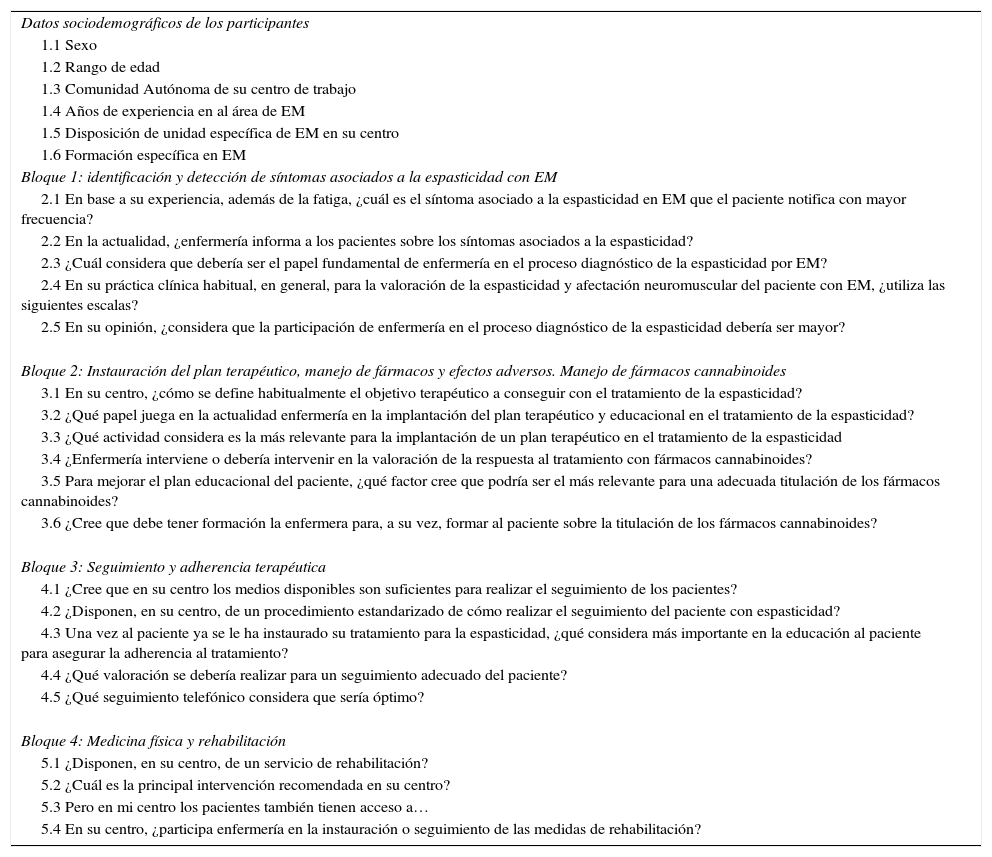Describir el papel de la enfermería en el manejo de los síntomas asociados a la espasticidad en esclerosis múltiple (EM).
MétodoSe elaboró un estudio descriptivo mediante encuesta sobre la espasticidad en pacientes con EM, que se respondió mediante televotación anónima en una reunión nacional con personal de enfermería implicado en el manejo de estos pacientes.
ResultadosEn opinión de los participantes, además de la fatiga el síntoma asociado a la espasticidad en EM más notificado por el paciente es la dificultad para caminar, seguido de espasmos y dolor. Los participantes opinan que es importante que enfermería tome: 1) un papel activo en la identificación de estos síntomas, 2) enfocarse en la detección de los factores desencadenantes o agravantes y 3) en prestar soporte en la valoración del nivel de espasticidad mediante el uso de escalas. Es importante informar del correcto uso de los fármacos antiespásticos, de cómo ajustar la dosis y de los efectos secundarios de los tratamientos, entre ellos, delta-9-tetrahidrocanabinol y cannabidiol (THC:CBD) en pulverización bucal, titulando sus dosis según cada paciente, y monitorizando su tolerabilidad, eficacia y adherencia. Aunque se suele disponer de medios para realizar el seguimiento de estos pacientes, todavía hay carencias importantes, entre ellas, la falta de un protocolo de seguimiento concreto.
ConclusionesEnfermería actúa como pieza clave en el proceso de identificación de síntomas, formación y seguimiento de los pacientes con espasticidad en EM.
To describe the role of nurses in the management of symptoms related to spasticity in patients with multiple sclerosis (MS).
MethodA descriptive study was developed based on a questionnaire on spasticity in MS patients. The questionnarie was completed through an anonymous tele-voting system at a national meeting with nurses involved in the management of these patients.
ResultsApart from fatigue, according to the opinion of the participants, the spasticity symptom associated with MS most notified by patients was difficulty in walking, followed by spasms and pain. Participants thought that it is important that nursing takes: 1) a role in identifying these symptoms, 2) should focus on the detection of the triggering or aggravating factors, and 3) on providing support in the assessment of the level of spasticity. It is important to inform about the correct use of anti-spasticity drugs, how to adjust the dosage and side effects of treatments, including cannabinoids via an oromucosal spray, titrating its doses according to each patient, and monitoring its tolerability, efficacy and adherence. Although there are usually resources to follow up these patients, there are still important gaps, including the lack of a specific follow-up protocol.
ConclusionsAlthough all the participants are experts in the management of patients with MS, there is still diversity in the functions they perform, and the available resources they have in their hospitals. Nurses act as a key element in the process of identification of symptoms, training and monitoring of these patients with spasticity in EM.
Artículo
Comprando el artículo el PDF del mismo podrá ser descargado
Precio 19,34 €
Comprar ahora









